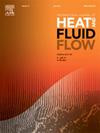光滑和粗糙墙面上的次对流压力波动比较
IF 2.6
3区 工程技术
Q2 ENGINEERING, MECHANICAL
International Journal of Heat and Fluid Flow
Pub Date : 2025-04-21
DOI:10.1016/j.ijheatfluidflow.2025.109835
引用次数: 0
摘要
比较了具有均匀分布粗糙度元素的光滑表面和粗糙表面的次对流壁面压力波动。由于测量技术的限制,测量光滑表面的次对流压力频谱具有挑战性,而且目前还没有适用于粗糙壁面的通用技术。本文介绍的研究采用了最近开发的一种方法来精确测量次对流压力波动,尤其是两个表面单一流动条件下的低波数压力波动。不同传感器之间的相关性表明,粗糙墙壁的尺度小于光滑墙壁。对流脊明显扩大。将波数-频率谱归一化为 ϕpp(k1δ∗,ωδ∗/Uc)Uc/τw2δ∗2 表明对流峰值处近乎完全塌陷。由于粗糙壁面对流脊行为,归一化频谱水平在次对流域显示出约 25 dB 的差异。相对于 20 μPa 的绝对次对流压力频谱水平比光滑壁面的对流压力波动低约 30 dB。粗糙墙壁的测量结果显示绝对水平比光滑墙壁高 15-20 分贝。在较高频率下,光滑墙壁和粗糙墙壁都出现了波白现象。光滑墙和粗糙墙的对流速度都与频率有关。粗糙墙壁的对流脊宽度与频率有关,而光滑墙壁的对流脊宽度在所有频率下都会收缩。本文章由计算机程序翻译,如有差异,请以英文原文为准。

Comparison of sub-convective pressure fluctuations over a smooth and rough wall
Sub-convective wall pressure fluctuations are compared for a smooth and rough surface with homogeneously distributed roughness elements. Limitations in measurement techniques make it challenging to measure the sub-convective pressure spectrum over smooth surfaces, and there are no general techniques for rough walls. The study presented here uses a recently developed approach to accurately measure the sub-convective pressure fluctuations, particularly at low-wavenumbers for a single flow condition for two surfaces. Correlations between different sensors suggest smaller scales in rough walls than in smooth walls. A significant expansion of the convective ridge is noticed. Normalizations of the wavenumber-frequency spectrum as shows a near-exact collapse at the convective peak. The normalized spectral levels show a difference of about 25 dB in the sub-convective domain due to rough wall convective ridge behavior. The absolute sub-convective pressure spectrum levels relative to 20 Pa are about 30 dB below the convective pressure fluctuations for smooth walls. Rough wall measurements show absolute levels 15–20 dB higher than the smooth wall. A wavenumber-white behavior is observed at higher frequencies for smooth and rough walls. Both smooth and rough walls show a convection velocity dependent on frequency. The rough wall convective ridge width shows a frequency dependency, whereas the smooth wall convective ridge width collapses at all frequencies.
求助全文
通过发布文献求助,成功后即可免费获取论文全文。
去求助
来源期刊

International Journal of Heat and Fluid Flow
工程技术-工程:机械
CiteScore
5.00
自引率
7.70%
发文量
131
审稿时长
33 days
期刊介绍:
The International Journal of Heat and Fluid Flow welcomes high-quality original contributions on experimental, computational, and physical aspects of convective heat transfer and fluid dynamics relevant to engineering or the environment, including multiphase and microscale flows.
Papers reporting the application of these disciplines to design and development, with emphasis on new technological fields, are also welcomed. Some of these new fields include microscale electronic and mechanical systems; medical and biological systems; and thermal and flow control in both the internal and external environment.
 求助内容:
求助内容: 应助结果提醒方式:
应助结果提醒方式:


